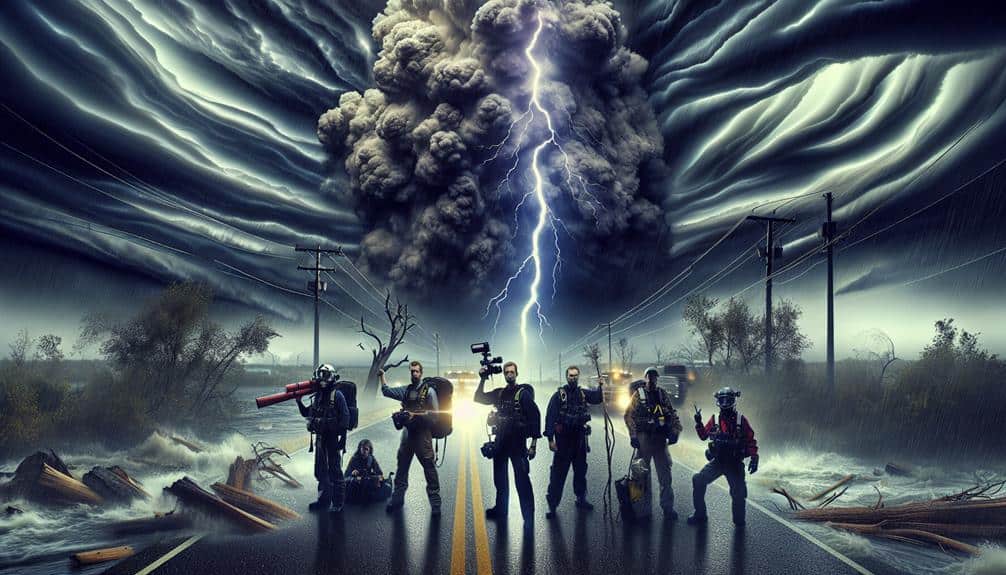As global temperatures rise, we're witnessing more frequent and intense storms. Warmer oceans provide additional energy, fueling hurricanes, typhoons, and cyclones. Increased water vapor leads to heavier rainfall and severe flooding. Empirical data from events like Hurricane Harvey show how added atmospheric heat amplifies storm destructiveness. The geographical distribution and timing of storms are shifting, bringing prolonged rainfall and extreme winds. Coastal regions face significant impacts from rising sea levels and storm surges, while inland areas encounter tornadoes and intense thunderstorms. Effective adaptation strategies, customized for regional vulnerabilities, are essential to mitigating these effects. Discover more insights about evolving patterns and mitigation efforts.
Key Points
- Rising global temperatures correlate with increased storm frequency and intensity due to more energy from warmer oceans.
- Increased atmospheric moisture from higher temperatures results in heavier rainfall and severe flooding during storms.
- Changing storm patterns include shifting geographical distribution and seasonal timing, leading to more intense and prolonged rainfall events.
- Regional variations necessitate customized adaptation strategies, such as seawalls for coastal cities and enhanced building codes for inland areas.
Rising Global Temperatures
As global temperatures continue to rise, we observe a direct correlation with the increased frequency and intensity of storms. These rising global temperatures contribute significantly to extreme weather events. Warmer oceans provide more energy, which fuels the development of more potent storms. We see this manifest in the form of hurricanes, typhoons, and cyclones that not only occur more frequently but also with greater intensity.
The environmental implications of this are vast. Higher temperatures lead to increased water vapor in the atmosphere, a key ingredient for extreme weather. This results in heavier rainfall and, consequently, more severe flooding. Our ecosystems, already fragile, face unprecedented stress. Coastal regions, in particular, are at heightened risk due to rising sea levels and more powerful storm surges.
Moreover, these changes disrupt weather patterns globally, causing prolonged droughts in some areas while others suffer from excessive rainfall. The agricultural sector, essential for our freedom and sustenance, is particularly vulnerable. Crops fail, livestock suffers, and food security becomes a pressing concern.
Increased Storm Intensity
The increasing strength of storms is directly linked to the rising levels of atmospheric and oceanic heat, providing more energy for these extreme weather events. As global temperatures rise, warmer air and sea surfaces contribute to increased evaporation, leading to higher humidity levels. This additional moisture in the atmosphere results in extreme precipitation during storms, significantly heightening the risk of flooding.
We've observed that hurricanes and typhoons aren't only becoming more frequent but also more potent. The boosted energy from warmer oceans translates to stronger winds and greater rainfall, magnifying the destructive potential of these storms. Coastal flooding becomes a serious concern, especially for communities with limited adaptive infrastructure. Rising sea levels worsen this issue, as higher baselines mean storm surges can penetrate further inland.
Empirical data supports this pattern. For instance, Hurricane Harvey (2017) and Typhoon Haiyan (2013) demonstrated unprecedented rainfall and storm surge levels, respectively. These events highlight the urgent need for adaptive measures.
We must recognize that mitigating this increased storm strength requires robust, evidence-based strategies to protect vulnerable regions and safeguard our freedoms aren't undermined by these escalating threats.
Changing Storm Patterns
Scientists have observed notable shifts in the geographical distribution and seasonal timing of storms, driven by climate change. We've seen changes in storm frequency, with some regions experiencing more frequent storms while others see a decline.
For instance, the North Atlantic has recorded an increase in hurricane activity, while other areas face less frequent but more intense storms. This shifting trajectory of storm paths is a direct result of altered atmospheric and oceanic conditions.
Moreover, changing precipitation patterns have become evident. Storms now carry more moisture, leading to heavier and more prolonged rainfall events. This increase in precipitation can cause significant flooding, posing threats to both urban and rural areas.
Additionally, the intensity of extreme winds during storms has also escalated. Higher sea surface temperatures and altered wind patterns contribute to these extreme winds, making storms more destructive.
Our analysis indicates that these changing storm patterns are a complex interplay of various climatic factors. The freedom to understand and adapt to these shifts is pivotal for developing effective mitigation and adaptation strategies.
As we continue to study these trends, our ability to predict and respond to changing storm patterns will become increasingly essential.
Regional Variations
Regional variations in storm impacts highlight the diverse effects climate change has on different parts of the world, necessitating customized adaptation strategies. Coastal regions, for instance, are increasingly facing more intense hurricanes and typhoons due to rising sea surface temperatures. These regional impacts often worsen local vulnerabilities, such as the susceptibility of low-lying areas to storm surges and flooding.
Inland areas aren't immune either; they experience heightened risks from extreme weather events like tornadoes and intense thunderstorms.
Our understanding of these regional impacts underscores the need for localized adaptation strategies. For coastal cities, measures might include constructing seawalls and improving early warning systems. In contrast, inland regions may focus on enhancing building codes and investing in storm shelters. Evidence suggests that personalized strategies markedly reduce the human and economic toll of extreme weather.
Moreover, we must consider socio-economic factors in these adaptation strategies. Communities with limited resources are often the most vulnerable, requiring targeted assistance to build resilience. By focusing on local vulnerabilities and regional impacts, we can craft more effective adaptation strategies that offer a greater degree of freedom from the devastating effects of climate change-induced storms. This approach ensures that our responses are both fair and efficient.
Future Projections

Looking ahead, we can expect climate change to worsen the frequency and intensity of storms, posing greater challenges for mitigation and adaptation efforts. Climate models consistently project an increase in extreme events as global temperatures rise. This results from warmer ocean surfaces providing more energy to fuel storms, leading to more severe weather phenomena.
To prepare for these future projections, we must focus on both mitigation strategies and adaptation measures. Here's what we need to prioritize:
1. Enhanced Climate Models:
Investing in more advanced climate models can improve our ability to predict extreme events, allowing for better-prepared communities and safer planning.
2. Mitigation Strategies:
Implementing robust mitigation strategies, such as shifting to renewable energy sources and reducing greenhouse gas emissions, can help curb the pace of climate change and its impacts on storm activity.
3. Adaptation Measures:
Developing effective adaptation measures, including improved infrastructure, early warning systems, and community education, will be vital to minimize the damage from increasingly severe storms.
Frequently Asked Questions
How Can Individuals Prepare for More Frequent and Intense Storms?
We need to prepare for more frequent and intense storms by developing thorough evacuation plans and maintaining well-stocked emergency kits. Evidence shows that proactive planning notably increases survival rates and guarantees our freedom during crises.
What Are the Economic Impacts of Climate Change on Storm Damage and Recovery?
When storm clouds gather, our wallets feel the thunder. Economic losses surge, with insurance payouts and infrastructure repairs straining budgets. Recovery efforts often lag, highlighting the need for resilient systems to safeguard our financial freedom.
How Does Urban Planning Influence Storm Resilience in Populated Areas?
Urban planning boosts storm resilience through green infrastructure, reducing runoff and enhancing flood control. Effective design improves disaster response, enabling faster recovery and minimizing economic impacts. We can achieve greater freedom by optimizing our urban environments.
What Role Do Renewable Energy Sources Play in Mitigating Climate Change Effects on Storms?
Harnessing renewable energy sources is a game-changer in our energy shift. Through sustainability initiatives and green technologies, we can reduce storm impacts. Environmental policies drive this change, proving our commitment to a resilient, free future.
How Can International Cooperation Aid in Better Storm Prediction and Preparedness?
International cooperation enhances storm prediction and preparedness by leveraging global partnerships, technology advancements, and extensive data sharing. These efforts enable early warning systems, empowering communities to act swiftly and mitigate potential impacts effectively.


